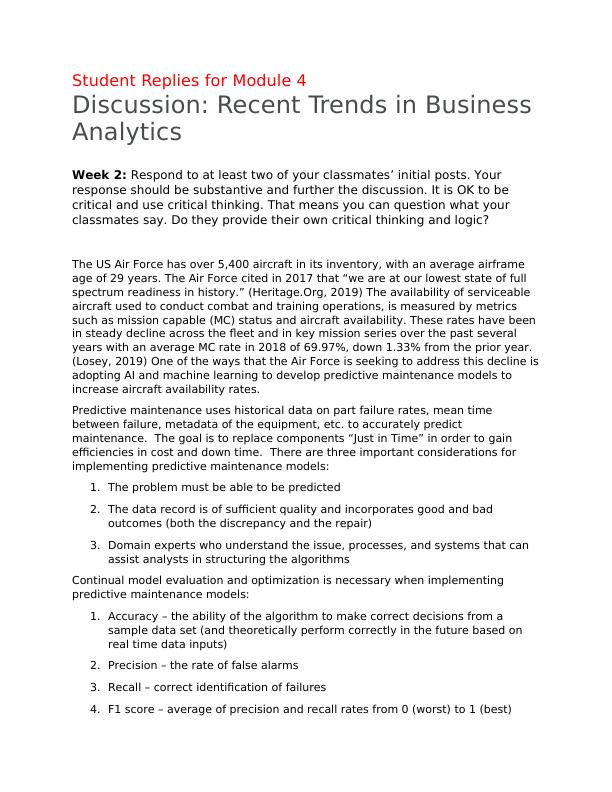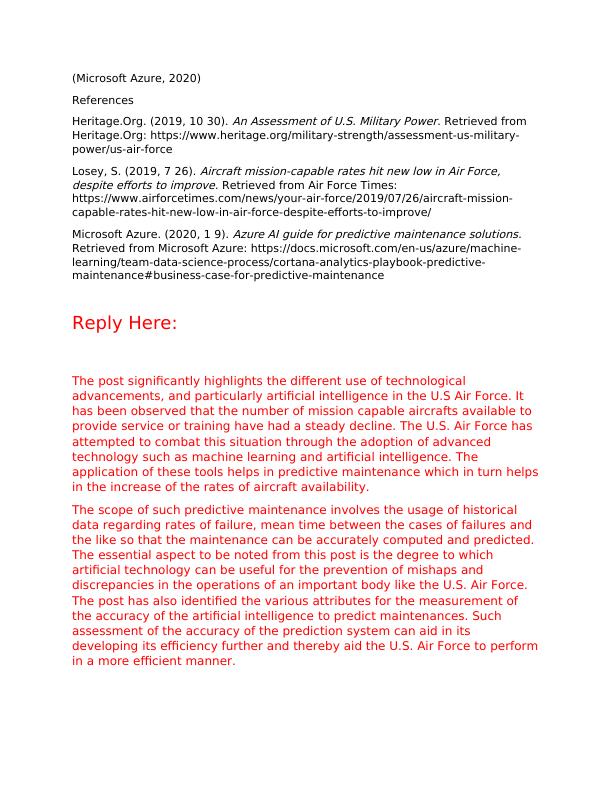Student Replies for Module - Recent Trends in Business Analytics
4 Pages1334 Words9 Views
Added on 2022-08-20
Student Replies for Module - Recent Trends in Business Analytics
Added on 2022-08-20
ShareRelated Documents
Student Replies for Module 4
Discussion: Recent Trends in Business
Analytics
Week 2: Respond to at least two of your classmates’ initial posts. Your
response should be substantive and further the discussion. It is OK to be
critical and use critical thinking. That means you can question what your
classmates say. Do they provide their own critical thinking and logic?
The US Air Force has over 5,400 aircraft in its inventory, with an average airframe
age of 29 years. The Air Force cited in 2017 that “we are at our lowest state of full
spectrum readiness in history.” (Heritage.Org, 2019) The availability of serviceable
aircraft used to conduct combat and training operations, is measured by metrics
such as mission capable (MC) status and aircraft availability. These rates have been
in steady decline across the fleet and in key mission series over the past several
years with an average MC rate in 2018 of 69.97%, down 1.33% from the prior year.
(Losey, 2019) One of the ways that the Air Force is seeking to address this decline is
adopting AI and machine learning to develop predictive maintenance models to
increase aircraft availability rates.
Predictive maintenance uses historical data on part failure rates, mean time
between failure, metadata of the equipment, etc. to accurately predict
maintenance. The goal is to replace components “Just in Time” in order to gain
efficiencies in cost and down time. There are three important considerations for
implementing predictive maintenance models:
1. The problem must be able to be predicted
2. The data record is of sufficient quality and incorporates good and bad
outcomes (both the discrepancy and the repair)
3. Domain experts who understand the issue, processes, and systems that can
assist analysts in structuring the algorithms
Continual model evaluation and optimization is necessary when implementing
predictive maintenance models:
1. Accuracy – the ability of the algorithm to make correct decisions from a
sample data set (and theoretically perform correctly in the future based on
real time data inputs)
2. Precision – the rate of false alarms
3. Recall – correct identification of failures
4. F1 score – average of precision and recall rates from 0 (worst) to 1 (best)
Discussion: Recent Trends in Business
Analytics
Week 2: Respond to at least two of your classmates’ initial posts. Your
response should be substantive and further the discussion. It is OK to be
critical and use critical thinking. That means you can question what your
classmates say. Do they provide their own critical thinking and logic?
The US Air Force has over 5,400 aircraft in its inventory, with an average airframe
age of 29 years. The Air Force cited in 2017 that “we are at our lowest state of full
spectrum readiness in history.” (Heritage.Org, 2019) The availability of serviceable
aircraft used to conduct combat and training operations, is measured by metrics
such as mission capable (MC) status and aircraft availability. These rates have been
in steady decline across the fleet and in key mission series over the past several
years with an average MC rate in 2018 of 69.97%, down 1.33% from the prior year.
(Losey, 2019) One of the ways that the Air Force is seeking to address this decline is
adopting AI and machine learning to develop predictive maintenance models to
increase aircraft availability rates.
Predictive maintenance uses historical data on part failure rates, mean time
between failure, metadata of the equipment, etc. to accurately predict
maintenance. The goal is to replace components “Just in Time” in order to gain
efficiencies in cost and down time. There are three important considerations for
implementing predictive maintenance models:
1. The problem must be able to be predicted
2. The data record is of sufficient quality and incorporates good and bad
outcomes (both the discrepancy and the repair)
3. Domain experts who understand the issue, processes, and systems that can
assist analysts in structuring the algorithms
Continual model evaluation and optimization is necessary when implementing
predictive maintenance models:
1. Accuracy – the ability of the algorithm to make correct decisions from a
sample data set (and theoretically perform correctly in the future based on
real time data inputs)
2. Precision – the rate of false alarms
3. Recall – correct identification of failures
4. F1 score – average of precision and recall rates from 0 (worst) to 1 (best)

(Microsoft Azure, 2020)
References
Heritage.Org. (2019, 10 30).
An Assessment of U.S. Military Power. Retrieved from
Heritage.Org: https://www.heritage.org/military-strength/assessment-us-military-
power/us-air-force
Losey, S. (2019, 7 26).
Aircraft mission-capable rates hit new low in Air Force,
despite efforts to improve. Retrieved from Air Force Times:
https://www.airforcetimes.com/news/your-air-force/2019/07/26/aircraft-mission-
capable-rates-hit-new-low-in-air-force-despite-efforts-to-improve/
Microsoft Azure. (2020, 1 9).
Azure AI guide for predictive maintenance solutions.
Retrieved from Microsoft Azure: https://docs.microsoft.com/en-us/azure/machine-
learning/team-data-science-process/cortana-analytics-playbook-predictive-
maintenance#business-case-for-predictive-maintenance
Reply Here:
The post significantly highlights the different use of technological
advancements, and particularly artificial intelligence in the U.S Air Force. It
has been observed that the number of mission capable aircrafts available to
provide service or training have had a steady decline. The U.S. Air Force has
attempted to combat this situation through the adoption of advanced
technology such as machine learning and artificial intelligence. The
application of these tools helps in predictive maintenance which in turn helps
in the increase of the rates of aircraft availability.
The scope of such predictive maintenance involves the usage of historical
data regarding rates of failure, mean time between the cases of failures and
the like so that the maintenance can be accurately computed and predicted.
The essential aspect to be noted from this post is the degree to which
artificial technology can be useful for the prevention of mishaps and
discrepancies in the operations of an important body like the U.S. Air Force.
The post has also identified the various attributes for the measurement of
the accuracy of the artificial intelligence to predict maintenances. Such
assessment of the accuracy of the prediction system can aid in its
developing its efficiency further and thereby aid the U.S. Air Force to perform
in a more efficient manner.
References
Heritage.Org. (2019, 10 30).
An Assessment of U.S. Military Power. Retrieved from
Heritage.Org: https://www.heritage.org/military-strength/assessment-us-military-
power/us-air-force
Losey, S. (2019, 7 26).
Aircraft mission-capable rates hit new low in Air Force,
despite efforts to improve. Retrieved from Air Force Times:
https://www.airforcetimes.com/news/your-air-force/2019/07/26/aircraft-mission-
capable-rates-hit-new-low-in-air-force-despite-efforts-to-improve/
Microsoft Azure. (2020, 1 9).
Azure AI guide for predictive maintenance solutions.
Retrieved from Microsoft Azure: https://docs.microsoft.com/en-us/azure/machine-
learning/team-data-science-process/cortana-analytics-playbook-predictive-
maintenance#business-case-for-predictive-maintenance
Reply Here:
The post significantly highlights the different use of technological
advancements, and particularly artificial intelligence in the U.S Air Force. It
has been observed that the number of mission capable aircrafts available to
provide service or training have had a steady decline. The U.S. Air Force has
attempted to combat this situation through the adoption of advanced
technology such as machine learning and artificial intelligence. The
application of these tools helps in predictive maintenance which in turn helps
in the increase of the rates of aircraft availability.
The scope of such predictive maintenance involves the usage of historical
data regarding rates of failure, mean time between the cases of failures and
the like so that the maintenance can be accurately computed and predicted.
The essential aspect to be noted from this post is the degree to which
artificial technology can be useful for the prevention of mishaps and
discrepancies in the operations of an important body like the U.S. Air Force.
The post has also identified the various attributes for the measurement of
the accuracy of the artificial intelligence to predict maintenances. Such
assessment of the accuracy of the prediction system can aid in its
developing its efficiency further and thereby aid the U.S. Air Force to perform
in a more efficient manner.

End of preview
Want to access all the pages? Upload your documents or become a member.
